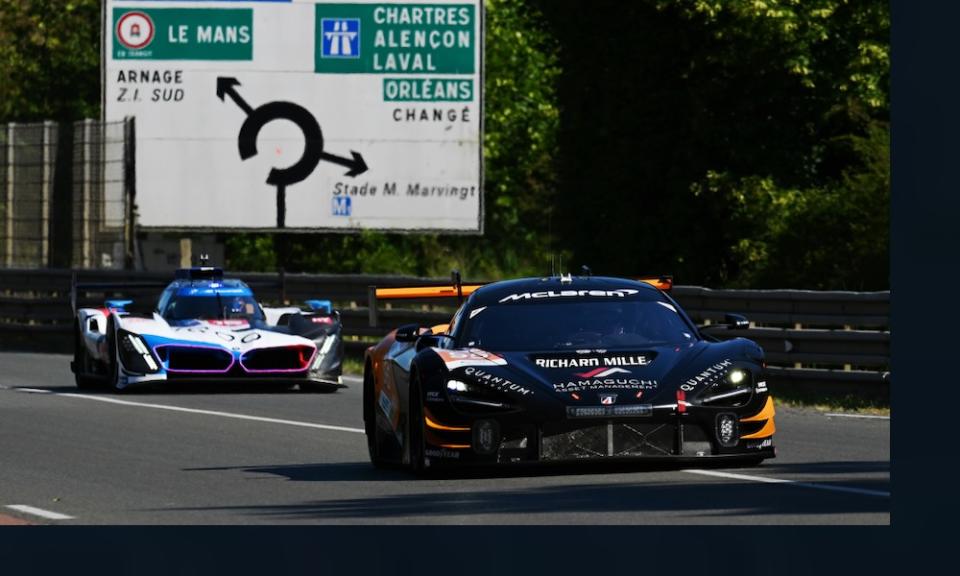Ruleset extension boosts prospects for McLaren Hypercar program

McLaren is still in play to enter the FIA World Endurance Championship’s Hypercar ranks as a manufacturer in the future, following the ACO and FIA’s decision to extend the current ruleset by two years to the end of the 2029 season.
At Le Mans, McLaren Racing CEO Zak Brown and McLaren CEO Michael Leiters made it clear that they welcome the extension, which was announced on Friday during the ACO’s annual press conference. Brown said McLaren could now realistically develop a car in time for a debut in 2027, giving it at least three years to compete before the end of the regulation cycle.
“I think cost in all motorsport is critically important and the extension definitely helps our business model that we have laid out internally,” Brown said. “If — and I’d like to say it’s more ‘when’ than ‘if’ we step up to the top class — the extension is favorable. It gives us more breathing space because you wouldn’t want to enter a championship in its last season.”
McLaren holding an interest in Hypercar is nothing new. It has been keeping an eye on the current ruleset for several years and is believed to have come close to signing off on a program on multiple occasions. So beyond the ruleset extension, what if anything has changed to tip the scales this time?
Brown noted that McLaren Racing’s Formula 1, IndyCar, Formula E and Extreme E programs are now all delivering strong results. Perhaps even more importantly, the team is in a better place financially now than in years past.
“We think it (a Hypercar program) would be great for the brand. We love sports car racing, we have a lot of stuff going on in our business. On the racing side, we needed to get our Formula 1 team back to the from and it is now very close. Our IndyCar team is also strong,” he said.
“We need to make sure that if we take on another project it doesn’t disrupt our activities. I think we are not far away from feeling comfortable and I think we could take on another project without diluting our Formula 1 team, our IndyCar team or electric racing.
“We are turning a profit. McLaren Racing is very healthy. So then it’s just about timing. It takes a couple of years to get ready, so if you were going in 2026 you’d need to make a decision tomorrow, and we are not going to make one tomorrow. It’s just about getting our businesses aligned. But I think the excitement is there. I think you are looking at 2027 at the soonest.”
The engine regulations also proved a sticking point in the past, as the crank on McLaren’s current V8 is too high. But Leiters dismissed the idea that engine choice would be a barrier this time.
“First we have to take a decision on when and how to do that (the program) and then we come to the engine,” he said. “It would be perfect to have an engine in line with the road car programs — that would be the dream. But we would never compromise anything for competitiveness.”
Should McLaren bite the bullet and sign off a Hypercar program, putting it in contention for an overall Le Mans victory for the first time since 1998, what would it look like? Brown was clear that the LMDh ruleset remains the most appealing option. He also confirmed that the new “two-car” rule for manufacturers wouldn’t be a sticking point because it would be “the right business model and not an issue.”
As for the team that would operate the cars in the WEC, McLaren would not have to look far for an ideal candidate. You could reasonably expect that United Autosports — which now competes with McLaren in the WEC’s LMGT3 class — would be a front-runner due to its desire to compete in Hypercar, its capacity, its resources and its connection to McLaren via Zak Brown, who co-owns the team along with Richard Dean.
Brown was noncommittal when asked about the likelihood of bringing a McLaren Hypercar to IMSA GTP, and about making customer cars available as part of its financial model to fund the potential program.
“Our current business plan would be us going racing as a works team,” Brown said. “I think if a customer wanted to race a car or two it would be something we would discuss, but that’s not contingent on the plan. We certainly wouldn’t be opposed to it.”
Brown and Leiters also spoke about McLaren’s customer GT program. Its current GT3 platform is now referred to as the GT3 Evo, as the car was homologated as the now out-of-production 720S. Does this mean that a new model is in the works?
“It is not yet planned for now. On the Evo, we have made modifications to make it better and the platform works so well that there is no need to make a big update on the race car,” Leiters said.
Next year is a significant one for McLaren, as it celebrates the 30th anniversary of its overall victory at Le Mans in 1995 with the F1 GTR. Leiters teased that it is currently working on special plans for the event to mark the occasion.
“We have good ideas, but things you would not expect,” he said.

 Yahoo Autos
Yahoo Autos 